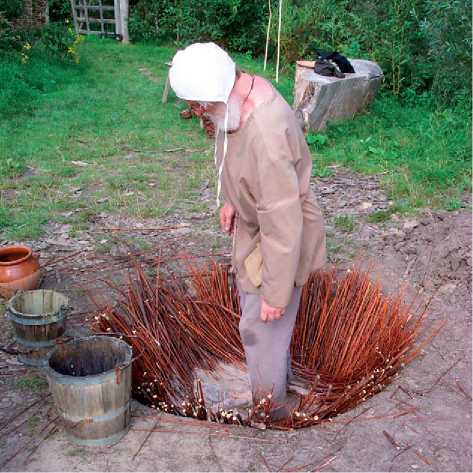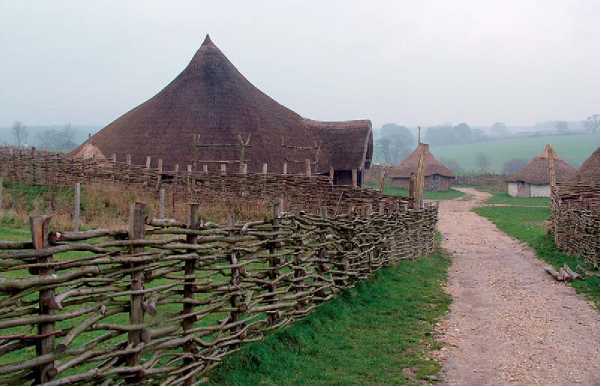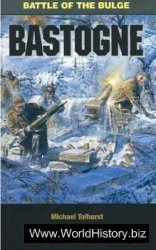The phrase ‘experimental archaeology’ (sometimes called ‘archaeology by experiment’) is used in various ways and people mean different things by it. It is not necessarily only laboratory experiments according to scientific laws (Figure 12).

Figure 12 Experiment with medieval fulling of wool at the His-torisch OpenluchtMuseum Eindhoven, the Netherlands. Picture: H. van Doormalen.
Building Reconstructions in Archaeological Open-Air Centers
Reconstructed or constructed houses are seen as the most tangible results of scientific experimentation. In books and brochures, one can read statements like: ‘‘the building of our museum was an act of experimental archaeology’’. These are, however, rather acts of personal experience.
A construction alone might be at best a by-product of experimental research, and nothing more. The real product of an experiment is data. The construct, or model, serves other goals. Changes are made in the possible reconstruction before it has even left the drawing room, as it is made fit for future use, ready to be a part of the ‘prehistoric’ or ‘medieval’ scenery.
An archaeological open-air center however, keeps the pretension high up; there is talk about a scientific experimental (meaning ‘true’) image of the past. Archaeologists do not like that and stay away, even if they once were enthusiastically involved. A point is made about what kind of knowledge is mediated, what is based on science and what on other sources. But this coin has two sides: ‘mistakes’ are also made in the field because of lack of interest of archaeologists to get involved, maybe because they are afraid to get beyond what they think is possible in archaeology.
Educational Programs for Children
Experimental archaeology is as often used to describe what is actually museum education. An employee helps children to make a pouch, cut a spoon, or sail a canoe. Obviously, these are not experiments, but by using this phrase, open-air centers want to point to the fact or assumption that they are offering serious activities, and we are not dealing here with entertainment only.
Generally seen, the activity (the fun) is not the focal point; rather, it is more a means to transfer the message which should be told in an open-air center. Needless to say, the lesson learnt about the past needs to reflect on the present as well.
Demonstrations for Public, or Living History
Demonstrations of any kind provide the connection between textbooks and reality, between knowledge learned by heart and knowledge gained by experience.
Besides education programs for children, at special open days or events, actors are hired who either give a demonstrations in crafts, fighting, cooking, or whatever more is interesting, or they try to sell certain products which carry the atmosphere of prehistory or the Middle Ages. The public has a great influence on what is successful, it is not the most authentic items which sell best or the most authentic crafts or activities which are rewarded most. These activities and products are not rewarded for their authenticity, but for the way they succeed in connecting with the modern public. It all happens in the present and is inspired by the past. The past is not a touchstone, merely the major source of inspiration.
Using living history actors, sometimes employed by the center, but most often hobbyists active on weekends and holidays, is a successful approach. But the people are ‘actors’. Some of them are very well informed about ‘their’ past, others are not. As an uninformed outsider, which the public generally speaking is, it is impossible to detect the difference. Both the actors as well as the open-air centers carry a responsibility. One of the major problems of living history is that it is hard to make clear that at this point a past is presented, not the past.
Trying Out a Technique, Occasionally
Most archaeologists have, once or more often in their lives, tried out or gotten acquainted with a technique. This is a good way to learn more about the qualities of one’s artifacts or one can imagine, for example, how much time it would have taken for an experienced group of people to build a house in the Iron Age. With this background experience, one might then be able again to imagine more about the people living in such a Iron Age world. However, measuring the quantity of time for cutting out a tree canoe might actually tell us nothing of how much time it took in the past. Answering this question tells one in the first instance more about one’s own capabilities and handicaps than it gets us acquainted with our predecessors.
It takes another step further, repeating the experiment. First then, it is possible to make more valuable judgments. That one (if one is archaeologist or craftsman or both does not matter) has to follow a more structured approach is almost inevitable.
The larger part of the experiments being presented in books and articles are onetime experiments, with no thought of, or approach to, repeatability.
In the respect of trying out a technique, the misunderstanding between experiment and primitive technology should be enlightened. The use of a mere technical approach differs from experimental archaeology in that trying to approach the past culture is not necessarily a means; it is the materials and techniques themselves that are the focal point. Primitive technology is a processual approach to experimental archaeology and it depends on the archaeologist to make a step further or not, to feed his experience back to the original data or not.
Primitive technology has been developed and fostered both in America and in Europe. One of the people in the United States who stood at the beginning of this approach is Errett Callahan. He started teaching himself flint knapping as early as in 1956 and has made it a point to share his knowledge learnt through experience with many others. His important projects are the Pamunkey Project, the Cahokia Pit House Project, and his Danish daggers project, most of them awaiting final publication. At the end of the 1980s, the Society of Primitive Technology (Http:// Www. primitive. org) was established by Callahan and others, being a low-profile but highly effective society in bringing together craftspeople who are serious about ancient crafts. In Europe, an important impetus to the study and promotion of primitive technology was given by Tomas Johansson from Sweden, who established the Society for Prehistoric Technology in 1980, publishing a popular magazine on the subject until 1995. He established courses for would-be experimental archaeologists in a national academy and was, in 2001, one of the founders of a European network of archaeological open-air centers, EXARC (Http://www. exarc. eu).
Scientific Experiments
Feynman et al. (1963) stated: ‘‘The test of all knowledge is experiment. Experiment is the sole judge of scientific ‘truth’.’’
The natural scientific method is by far not the only way to learn more about the past. It is only that using this method will not bring us far enough. But it is the best way to go beyond assumptions, ideas, possibilities, and hypotheses.
Exeter University, UK, is the only university in the world so far which offers an MA in experimental archaeology (Http://www. ex. ac. uk). It is designed to give practical experience of many ancient technologies and to embed these experiences within current scientific and academic theories, methodologies, and presentations to the profession and public.
In the nineteenth century, it was mere technical curiosity about individual objects which drove people to do experiments. From the 1960s onward, theoretical foundations were laid under experimental archaeology.
Ascher discerns different kinds of experiments, from imaginative experiments, which never leave the drawing room, to the comparative experiment (‘‘is my excavation technique better then yours?’’), up to imitative experiments, where archaeologists try to set up an imitation of a situation as it could have been in the past, in order to test their beliefs about past cultural behavior.
It has been a discussion over the years as to which categories of activities would fall under ‘experimental archaeology’ and which would not. Is it an archaeological experiment if one experiments methodologically with different excavation techniques? This depends on the background of the archaeologist answering such questions.
Experimental archaeology follows the trends in mainstream archaeology. The kind of hypotheses archaeologists postulate dictates a certain approach to experiments, but the theory behind experimental archaeology as a whole also follows the tendencies in general archaeology. The description of what experimental archaeology is and what it should be limited to followed under the ‘processual archaeology’ the rules of being interdisciplinary and searching for laws on which human behavior was supposed to be based (see Processual Archaeology). This meant the rise of experimental research in postdepositional processes, technology, and function of artifacts. Ascher reasoned that all human behavior would follow a pattern (a dynamic concept with different steps following each other). A division in groups of experiments would be best following the way of production and use of the artifact. The artifacts and the cultural behavior of which they were produced were focused upon, the human factor was described as following laws, not culturally determined.
Reynolds’ division of different kinds of experiments (1999) was meant to divide and control experimental archaeology better. Before he starts, he makes a clear difference between experiment, experience, and education. These three, however, touch upon each other frequently. He introduced experimental archaeology as a means to learn much more, partly by experience, partly by inference about the past.
Many experiments produce new data, but they are seldom fed back to the original data, the archaeological record. An experiment must fit into the dogma of the discipline. A hypothesis like ‘‘people in the Iron Age had a relaxed life’’ would not fit into the dogma of archaeology as it cannot be tested by using archaeological data. It has not and cannot be a subject of archaeological research - therefore it cannot be the subject of an archaeological experiment. Experiments require to be replicable and need to be replicated. And, to prevent too much subjectivity, the experiment should be designed as such, that the outcome can be statistically assessed.
Archaeological data can lead to a testable hypothesis. An experiment can be used to falsify this hypothesis and simultaneously lead to new hypotheses. In some cases, an experiment is run, solely to generate hypotheses, which in later experiments need to be tested. Experiments can validate a hypothesis, but cannot prove anything. There might be another hypothesis which could lead to the same results.
Reynolds makes five categories of experiments, of which the construct experiment is the first. This is the kind of experiment which is often labeled as ‘reconstruction’. As the use of the word ‘reconstruction’ implies a high level of certainty, the word ‘construct’ was introduced.
A construct in itself is a low-grade experiment. The real results of an experiment are data, derived from the actions of the experimental archaeologist. Obviously, these experiments have more materialistic results as side effects, but that is because archaeology - the prime but not the only source of the data on which an experiment is based - is involved in material culture.
Constructs can be classified into a hierarchical system, devised by Coles:
• A simple construct would only look like how the original artifact might have been - it would give an impression, like for a Hollywood movie (‘‘If a Stone Age man could have come alive again and seen the models I made, I expect he would have flung himself and laughed until he cried (...) No one was going to catch me saying that I intended to build a Stone Age house as it really had been, but only as it might have been’’ (Hansen, 1964, 18)).
• A second level is about making something that looks the same, but is also produced with the same materials, tools, and techniques as presumed in the original. This artifact stands on itself.
• The final level of reconstructions would not only involve the artifact made in the original way but also having it used in the presumably original
Fashion. This way, the artifact can tell us more about the past cultural context - as far as we can pursue this. This final category is setting the reconstruction into an experimental framework as it is such action, such use which creates data (e. g., through wear of the authentically used reconstruction) which we can compare again to the archaeological data.
The second level of Reynolds’ experimental division refers to process and function. It seeks to examine how things were achieved and involves a passage of time. At Butser Farm, for example, storage pits were made, like the ones used in the Iron Age, and these were used for a period of over 10 years.
The third category of Reynolds is called simulation when archaeological material is projected back into the state of what it might have looked like when still used in the past. A construct of an artifact or a set of artifacts is made and the deterioration through time is monitored. This is a waY to see how the archaeological record came to be.
Reynolds built a few roundhouses, basing his work as much as possible on archaeological data, and carefully monitored the decay, that is, the weaknesses of such a structure. With this experience, over the years he could argue as to exactly what the construction of such houses could have been like: for example, a difference in roof construction immediately has effects on the floor plan and the strength of the house (see Figure 13).
Another good example is the experimental earthworks at Overton Down and Wareham in the UK. In the early 1960s, different mounds and earthworks were constructed in these locations in order to determine the effectiveness of prehistoric tools in constructing them. However, the second purpose is the most important. With a binomial progression of years, a part is excavated and the degradation is compared to the earlier obtained data and to archaeological sites. In the earthworks, pseudo-artifacts are planted, whose deterioration and movements are also charted. This is a long-lasting simulation experiment.
The fourth series of experiments under Reynolds’ system is called ‘eventuality trial’ and incorporates all the three earlier categories. It seeks to explore the potential product, for example, the agricultural potential of the past. The greatest problem here is to establish the limits against which the variables can be examined. One can monitor harvest yields of prehistoric crops on similar soils as used in those days, but one can imagine the multitude of uncontrollable variables. Repeating the experiment over a number of years at different locations gives a better statistical value but the results remain the product of a specific combination of variables. How else could you infer how much land a family would need for agriculture?
The last category Reynolds describes is called ‘technological innovation’ and is about the testing of new scientific equipment in archaeology to improve archaeological data acquisition.
An important element in present-day descriptions of experimental archaeology is whether or not there is a feedback possible to the original archaeological data.
A recent definition as stated by Mathieu (2002, 1) states experimental archaeology to be: ‘‘a sub-field of archaeological research which employs a number of different methods, techniques, analyses, and approaches within the context of a controllable imitative experiment to replicate past phenomena (from objects to systems) in order to generate and test hypotheses to provide or enhance analogies for archaeological interpretation.’’

Experiments in this sense are attempts to imitate a situation as it might have been in the past. It is no longer about ‘reproducing’ an item. The experiment should be controllable, meaning it should be performed in a laboratory environment, albeit an open-air site. The possibility to control the necessary variables is more important then having the activity done in a seemingly authentic way. If authenticity is more important, the experiment turns into a demonstration or living history.
An experiment in the modern archaeological sense is about replicating objects (in its simplest form), replicating behaviors (as far as we can approach these) up to replicating systems, although this latter is hard to achieve. It is no longer about ‘making’ an object, but about ‘using’ it, or using a set of objects in a system. These actions result again in data which are comparable to the source data.
Experimental research either generates hypotheses or tests them. If an experiment is just about generating hypotheses, it is more an activity to gather experiences, to make an inventory of the variables playing a role in a certain activity. In this case, it follows a more general approach instead of being a well-thought-out plan. If one has already made an inventory of all variables and is able to measure and control all of them, one can continue to either try to falsify the hypothesis or accept the hypothesis for the moment. A successful experiment cannot lead to a one-to-one explanation or even evidence. A hypothesis is only valid as long as there is no proof that supports an alternative.
An experiment is about creating a data set which forms an analogy with the original archaeological data set which needs to be explained. Using an analogy implies one can supplement characteristics of one situation (the modern experiment in this case) to the other (the archaeological situation under investigation). Both situations need to be as similar as possible. We have in both situations statics: artifacts and structures. The action which resulted in these statics in the past is what we want to learn more about. If we then use similar artifacts and structures in a presumably similar way, we might be able to tell something of the actions (and consequently the people) leading to these statics.
A difficult point is whether the same action always leads to the same result and only that result. In other words, is it possible to explain the same data set with different actions? A good answer to this question will strengthen the analogy and therefore the value of the experiment.
An experiment would gain much value, if a few key issues are properly addressed. This can make the experiment much more worth its money and effort. An experiment needs to be measurable and repeatable, executed with the correct manual skill - not too high, but certainly not too low. One should base oneself on experience of those already having executed similar activities before, either as experiment, theory, or in ethnoarchaeological reports. In other words, a database should be kept about the subject in question. One should understand the technology and archaeology of the period and culture under investigation well - it is not just about trying out a technique and seeing if it works. During any stage in the experiment, one will find the need to improvise - and document these improvisations. Hardly ever does an experiment go exactly as planned.
A great problem with experimental archaeology, and at the same time its strength, is the versatility of the idea. The scope for enquiry is unlimited, but it attracts all manner of students (Coles, in Malina (1983)).
Theory without practice is empty; practice without theory is blind (Immanuel Kant, in Coles (1979, 243)).
See also: Butchery and Kill Sites; Ethnoarchaeology; Interpretation of Archaeology for the Public; Interpretive Art and Archaeology; Middle Range Approaches; Politics of Archaeology; Processual Archaeology; Tourism and Archaeology.




 World History
World History









